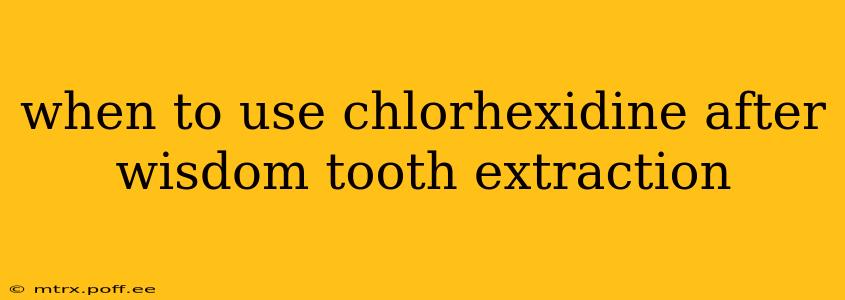Wisdom tooth extraction is a common procedure, but proper post-operative care is crucial for preventing complications like dry socket and infection. Chlorhexidine gluconate (often just called chlorhexidine) is a powerful antiseptic mouthwash frequently recommended by dentists to help maintain oral hygiene and promote healing after extractions. However, knowing when and how to use it effectively is key. This guide will clarify when you should start using chlorhexidine and address some frequently asked questions.
What is Chlorhexidine and Why is it Used After Wisdom Tooth Extraction?
Chlorhexidine is a broad-spectrum antiseptic that kills a wide range of bacteria, fungi, and viruses. Its effectiveness makes it an excellent choice for preventing infection after oral surgery like wisdom tooth extraction. The surgical site is vulnerable to infection, and chlorhexidine helps create a cleaner environment to promote faster healing and reduce the risk of complications.
When Should I Start Using Chlorhexidine After Wisdom Tooth Extraction?
This is a crucial question, and the answer depends largely on your dentist's specific instructions. Always follow your dentist's advice. There's no single universally applicable answer, as post-operative care can vary slightly depending on the complexity of the extraction and individual patient factors.
However, generally, you can expect to start rinsing with chlorhexidine within 24-48 hours of your surgery, after the initial blood clots have begun to form. Rinsing too early can dislodge the clot, leading to a painful and potentially serious complication known as dry socket.
How Often Should I Use Chlorhexidine After Wisdom Tooth Extraction?
Your dentist will provide specific guidance on the frequency of use, but typically, you'll rinse with chlorhexidine twice a day for a period of 7-10 days or as directed.
What are the Side Effects of Chlorhexidine?
While chlorhexidine is generally safe and effective, some people may experience temporary side effects such as:
- Brown staining of teeth: This is usually temporary and reversible once you stop using the mouthwash. Good oral hygiene can help minimize staining.
- Slight alteration of taste: Some individuals report a temporary change in taste perception.
- Burning or stinging sensation: This is common, especially if you have open wounds. Diluting the chlorhexidine with water may help alleviate this.
Can I Use Chlorhexidine with Other Mouthwashes?
It’s best to avoid using other mouthwashes concurrently with chlorhexidine unless your dentist specifically instructs otherwise. Other mouthwashes may interfere with chlorhexidine's effectiveness or cause undesirable interactions.
Is it Safe to Use Chlorhexidine if I'm Pregnant or Breastfeeding?
Always inform your dentist of your pregnancy or breastfeeding status. While chlorhexidine is generally considered safe, your dentist can assess your individual situation and advise on the appropriate use.
What Should I Do if I Experience Any Problems?
If you experience persistent pain, swelling, excessive bleeding, or other concerning symptoms after your wisdom tooth extraction, contact your dentist immediately.
What if I Forget to Use Chlorhexidine?
Don't worry too much if you miss a dose. Simply continue with your regular rinsing schedule. However, consistent use is important for optimal results.
This information is for general knowledge and should not be considered medical advice. Always consult with your dentist or oral surgeon for personalized post-operative instructions specific to your situation. They can provide the most accurate and relevant guidance on when and how to use chlorhexidine after your wisdom tooth extraction. Remember, following your dentist's instructions is crucial for a smooth recovery.
